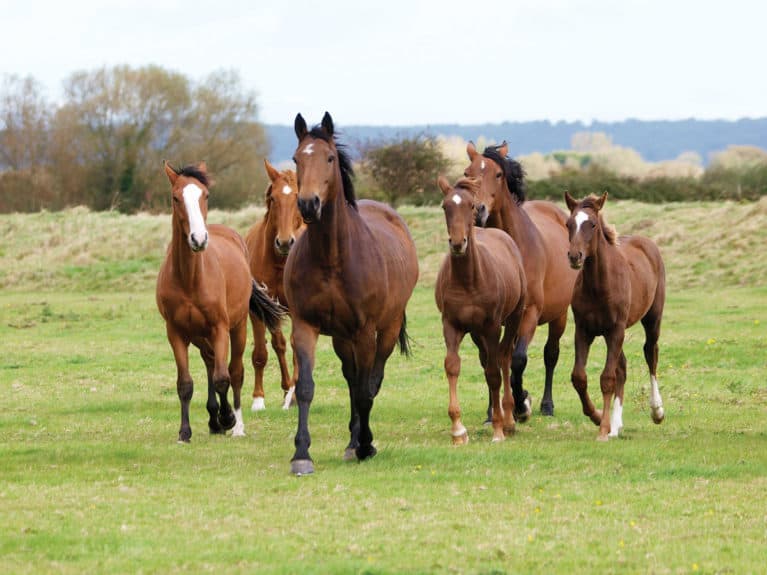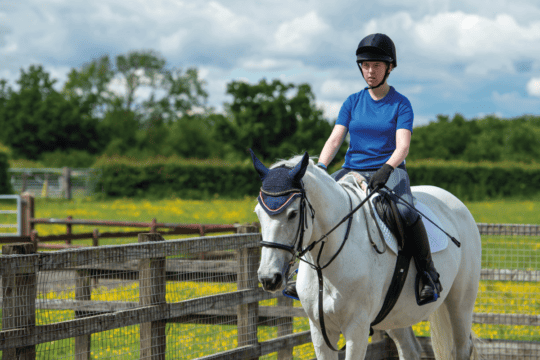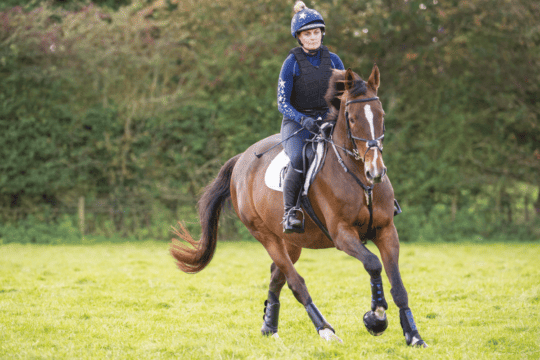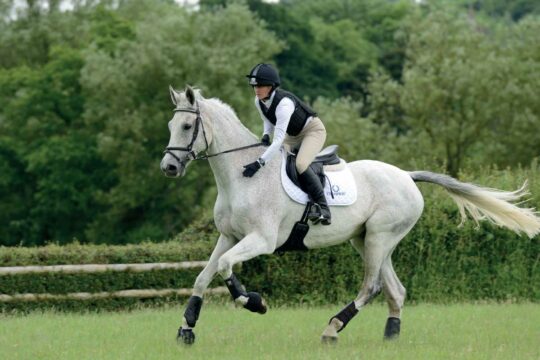Featured Professional

Anna Haines
Anna is a qualified Equine Behaviour Consultant based in Cheshire, who has been around horses for most of her life, having started riding at the age of five. She is a regular contributor to Horse&Rider and is a member of our 'Ask the Expert' team.
How much do you consider your horse’s natural social behaviour in his management? Probably not enough, as Anna Saillet explores

You’ve most likely stood at the field gate watching your horse interact with his fieldmates and wondered how their herd structure works. The reality is that the behaviours you see from your clipped, rugged, oversized pet are more similar to that of his wild relatives than you might imagine.
In natural environments, horses typically live in relatively stable social units. Horses live in herds so that they are able to fulfil their basic needs, which are to avoid danger or harm, and to reproduce successfully and bring up healthy foals. Group living offers security, which is particularly important for a prey species, and being with others provides opportunities to rest more easily, giving each group member additional protection from predators. Herd life requires horses to have a balanced co-operation with each other, and they communicate quickly and effectively through subtle body language.
Social groupings
The most commonly seen type of herd is one made up of mares who are sexually mature, their young offspring and one or more adult stallions. Typically, a stallion will form bonds and breed with several mares, and will defend them rather than a set territory. This is likely to be due to the importance of the herd being able to move to different areas between seasons to ensure they can find the best available source of food, rather than finding themselves restricted to just one area. However, this isn’t the only type of social group – there are herds made up of just mares and their offspring, sometimes resulting from the death of a stallion, and also bachelor bands made up of only male horses. Bachelor bands are often less stable groups than the family herds and have fewer individuals, often with no more than four members.
Certain adult mares have been found to develop mutual attachments to one another, preferring each other’s company to that of any other individual, and they may remain together even if there is no stallion with them.
More complex than you might think
It’s highly likely that you were brought up with the idea, put forward in books and even scientific studies, that horses organise themselves socially through the use of a pecking order. It was believed that the alpha animal in the herd was the most aggressive and enjoyed the most privileges, but also had more duties to perform than other herd members. It was thought that the alpha animal was dominant over the beta animal, and so on down the chain until reaching the unfortunate individual at the bottom who had no real control over anyone. However, a closer look shows us that equine herd life simply isn’t that simple, and this simplistic view fails to take into account the complexity of social organisation within a horse herd and how their behaviours and interactions may change depending on environmental factors.
The myth of dominance
As well as the outdated idea of a pecking order, many people have suggested that there is a lead stallion or mare of each herd who makes the decisions for the group, who are often the biggest and strongest of the group and are typically followed by all other group members. These individuals are often referred to as the dominant horse and several methods of horsemanship today insist on the importance of you becoming your horse’s leader, based on this school of thought that is, unfortunately, outdated.
A recent study looking at leadership in Przewalski horses found that, regardless of what definition of leadership was used, they could not find any horse who qualified as the leader. Instead, it was found that multiple horses contribute to group co-ordination and movements, and that horses’ rank positions within the herd can change depending on situations and context. Despite leadership being a term used widely in the equestrian world, there is no scientific study that has been able to quantitatively demonstrate that a certain individual consistently takes the role of the leader in group movements of animals.
This begs the question, why have so many schools of horsemanship based their methods around this theory of equine leadership? Whether you’re reading books, articles or online equestrian forums, you will often find people referring to horses as the dominant one in a group or as being dominant over his handler. A horse who chases another away from a pile of hay can still be good friends with him. Groups typically work as a co-operation together, and their relationships can change and develop over time, and are likely to alter depending on the availability of resources and each individual horse’s needs. While one horse may be dominant over another in certain situations, even if the second horse always submits to the first during any altercations, this does not mean that the first horse is dominant because dominance is not a personality trait. No horse, human or dog is born dominant, instead dominance is primarily a descriptive term for relationships between pairs of individuals and usually comes into play when one of the individuals wants access to particular resources.
Dominant behaviour can be demonstrated to enable the individual to gain or maintain access to a resource on any particular occasion. This is not, however, achieved through force or coercion, but through one of the individuals responding submissively without any aggression occurring. Just because one individual displays dominant behaviour in one situation does not necessarily mean that the same individual will show it on another occasion to either the same or another individual. Where you see an increase in bullying behaviours or possible dominance behaviours in domestic herds of horses, it’s mostly the result of the conditions the horses are kept in, where they feel there is a necessity to fight over important resources such as food, water, shelter or friends. In more natural environments, horses don’t have the need to argue over piles of hay, buckets of feed, access to a water bucket or space through gateways.
Horses can be friends, too
Friendships are extremely important in your horse’s life, with horses often forming close bonds with certain friends, spending time hanging out together, mutual grooming and standing nose to tail to swish each other’s flies away. Mutual grooming assists with the consolidation of friendships and it’s often observed that one horse in a pair of friends is slightly bolder than the other. Due to the close bond that a pair of horses can develop, a form of grieving can often be seen when the friends are separated. Like humans, horses all respond differently to the death of a close companion and a huge variety of reactions have been observed in these cases.
What feral horses can tell us
Studying wild horses is obviously the best way to understand more about the behaviour of their domestic cousins, but truly wild horses are extremely rare. However, feral populations are more common, so it’s helpful to look at the research going on into these groups to improve our understanding of equine behaviour.
Populations of feral horses exist across the world in a variety of different habitats, from deserts to mountains, forests to barrier islands. As a result of this, although there are behavioural and organisational strategies that are typical of all horses, the behaviours of feral horse herds also vary to enable them to thrive in their unique situations and environmental context.
Did you know?
The Przewalski horse is the world’s last truly wild horse. The International Union for the Conservation of Nature (IUCN) had declared these horses as extinct in the wild with the only ones remaining living in zoos. However, through ambitious breeding programmes, numbers of these horses greatly increased in captivity and there has been a successful reintroduction programme where four groups of horses were reintroduced to their natural habitat in Mongolia.
Going solo
Most importantly, horses don’t like to live alone and very few would ever do so by choice. While there may be some feral horses who live in solitude, this appears to be rare and is often due to circumstances out of their control. Horses are social animals – they have a natural desire for company and, as their carers and keepers, it’s our responsibility to ensure that they have this. Where circumstances prevent another horse from being kept as a companion, some people take on a goat or sheep to provide companionship instead. While this is preferable to the horse being completely isolated, be under no illusion that this is as good a solution as equine companionship. Other species cannot offer the same mutual benefits as another horse would and ideally a long-term solution of enabling equine company to be possible should be sought.
Stallions typically get a pretty raw deal with regards to how they are kept. Unfortunately, it’s still common practice for stallions to be kept completely socially isolated and to never have any interaction with companions other than when expected to cover a mare in extremely artificial circumstances. Sadly, because stallions are often kept isolated their whole lives, they lack appropriate social skills, so people become too concerned about turning them out with other horses because of their behaviour. Introducing any horse to living with company should always be a steady, gradual process, but stallions should have the same rights as every other horse we keep. It’s an equine need to have companionship and without the provision of this we are seriously impairing their welfare. Contrary to popular belief, it can be possible to keep stallions together provided they’re introduced carefully, and monitored and managed appropriately.
Sympathetic management
Due to the way that we manage horses – keeping them in small spaces, in often unstable, regularly changing groups with limited resources – we have taken away their natural abilities to regulate their own groups. Horses are often moved to different fields with different companions or even moved to an entirely new yard and each time one of these movements happens, the dynamics of the group will alter. Even separating horses when they come in to be stabled overnight during the winter can cause them to show more agonistic behaviours each day when they are turned out together again.
Horses develop strong, close bonds and this is often not considered or not taken seriously when owners consider whether they should move to a new field or yard. Repeated separation from companions can lead to the development of separation-related anxiety and could also contribute to the development of other behavioural problems due to an increase in stress experienced by the horse.
Where management conditions have created competition for resources among horses, care should be taken when introducing a new horse, as existing group members may try to bully a newcomer to prevent access to resources. The introduction of new horses to any existing herd should be gradual, ideally with the new horse being turned out adjacent to the herd, across a safe barrier, for a number of weeks before being fully introduced. Scent swapping can be really beneficial – simply put some of the new horse’s droppings into the existing herd’s field and vice versa so that they can start to learn all about each other before coming properly face to face.
Did you know?
In Switzerland, since 2008 it has been a legal requirement that all horses, ponies, donkeys and mules must be able to see, hear and smell other equines, and horses under two-and-a-half years old must be kept in groups to allow for social needs. Wouldn’t it be nice if the UK followed this welfare-friendly approach to make improvements for horses’ lives?
Your Comments
One thought on “Why should you keep your horse in a herd?”
Leave a Reply
You must be logged in to post a comment.
















What about older horses who are limited in defending themselves. I have a 23 year old former pacer who has DSLD and osteoarthritis. I have him in a private pasture and he can see and smell other horses but he seems very low key. He’s afraid of the shelter so stands outside all day and night. I blanket him and see him every day to feed and rub his legs down. I’m considering another farm where he will have a large stall, but will have to be put out with a herd. What do you think is the better situation for him? I want him to be as comfortable as possible but also don’t want to take away the comfort of a herd.